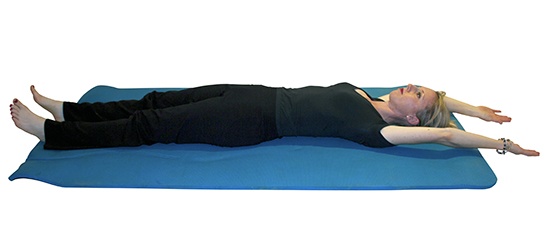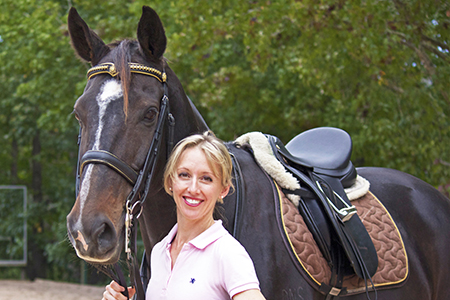By Rebecca Ashton
The roll up is a great exercise to work the core as well as the external abdominal (stomach) muscles, while stretching the back. When riding, the back can tend to lock into position a little too much. As riders, we aim to keep ourselves still, but because we are on top of a big, moving animal, our muscles have to actually be making constant, small corrections to maintain our balance. This exercise creates spinal mobility and effectively ìrolls outî any blockages in the back. For this to occur, the abdominals have to engage and scoop inwards, almost like a pulley system. When riding, the abs will support the back, so this is a good way to wake them up.
It is very tempting to execute the roll up quickly, however the slower you go the more benefit you will gain. Slow and controlled movement will give your body a chance to feel which muscles need to work or which need to let go instead of just using momentum and muscling through. It will fine tune your reactions.
When not to do this exercise: If you have spinal disc problems.
Variation: If you cannot execute a full roll up correctly, start by lying flat and rolling up only as far as you can while using controlled muscles and no jerking movements. Then, sit up and roll down only as far as you can with slow control. Eventually, the two exercises will meet in the middle! You can also start to do the roll up with bent knees to make it a little easier.
The Set Up
– Lie on your back with legs and arms straight and stretching in opposite directions. You want to maintain a neutral spine*. You will have a small space under your lower back and all the vertebrae of your mid-back and ribs will be settled and heavy against the floor.
– Switch off your outer muscles including hamstrings, calves and arms. We want the movement to originate from the deep, internal muscles, including the core*.
– On an in breath, using the lateral breathing* method, switch on your core by imagining the low abs melting inwards towards your spine and lifting up gently through the pelvic floor. When breathing, imagine filling up your lungs completely, including the sides and back, not just the front. The shoulders remain relaxed and still.
Instruction Of Move:
– raise your arms above your head, reaching for the ceiling
– breath out, reach forward, look into your belly and roll up one vertebrae at a time
– Stretch your arms forward towards the wall in front of you whilst keeping the abs scooped in towards the spine
– Breathe in
– Breathe out to roll back down, one vertebrae at a time.
Watch Out For:
– Executing the movement too quickly
– Using momentum instead of muscles to roll up
– Lifting your feet off the ground and using them as a lever
– Not keeping enough of a c-curve in the spine
– Hitching shoulders
– Rolling off your seatbones as you stretch forward
– Leading with one side of your body instead of keeping both sides of your body even.
Visualisations:
– Keep abs and chest heading back towards spine as you roll up and reach forward
– Keep abs scooped in and away from the thighs when reaching forward as if someone has shot a cannon ball into your stomach
– Think about what the bones are doing even more than the muscles
– Feel like your shoulders are connected to your hips to help keep them drawn down
– Try and count each of the 33 vertebrae as you roll up and down
Glossary
* Neutral Spine: This is the shape of the spine when all the vertebrae are stacked one upon the other in alignment. The spine is concave in the lower back and the neck. These natural curves allow for good shock absorption. This is what we term a neutral spine position and we want to maintain this alignment when we ride.
* Core: Your core is made up of some very deep muscles that help support your structure. They form a type of box in your lower abdomen. The top of the box is the diaphragm, the sides are formed by the internal obliques, and at the back is the multifidus which supports the vertebrae. At the front is the transversus abdominis and on the bottom is the pelvic floor. That is a lot of muscles to think about, so we focus mainly on the transversus and pelvic floor. Good breathing techniques will help take care of the diaphragm and correct exercise technique will support healthy obliques and multifidus. There are many ways to switch on the core, but the best way is to use imagery. Think that you are gently tightening a hipster belt, drawing up a pelvic elevator, stopping the flow of urine or melting your lower abs into your spine.
* Lateral breathing: This is style of breathing where we breathe in through the nose and out through the mouth. It helps support the core. Think of filling up the lungs without losing the engagement of the core or lifting the shoulders up. Remember to breathe into the sides and back of the lungs, not just the front. Donít forget, if youíre not used to good breathing techniques, the diaphragm and the intercostal muscles that control the rib cage will need time to learn to work properly, just like any other muscle.
This exercise can be taken into the arena and a modified version can be executed while sitting on the horse.
This article first appeared in the June 2012 issue of THM.





Horseback riding has always been one of my favorite ways to exercise, and I am glad to see there are ways to exercise your abs as you ride. Thanks for sharing the tips!